Power Jerk: How To, Benefits & Programming
Author:
Unlock your full potential by engaging with our experts and community! Have questions about your fitness journey or looking for expert advice on weightlifting techniques? Don’t hesitate — leave a comment below and Oleksiy Torokhtiy will provide a personalized answer and insights to help you reach your goals.
Torokhtiy is reader-supported. Some links are affiliate links, and we may earn a commission at no extra cost to you. See our disclosure page for details.
With a name like power jerk, you’re probably expecting something dynamic and exciting, and you’re completely right! That’s exactly what power jerk is and we really can’t think of anyone that wouldn’t benefit from it.
It gives you a full-body workout, it improves athletic performance, coordination, power, speed, strength… What’s not to like?
We’ll walk you through everything concerning this super fun exercise and by the end of the article, you’ll see why we love it.
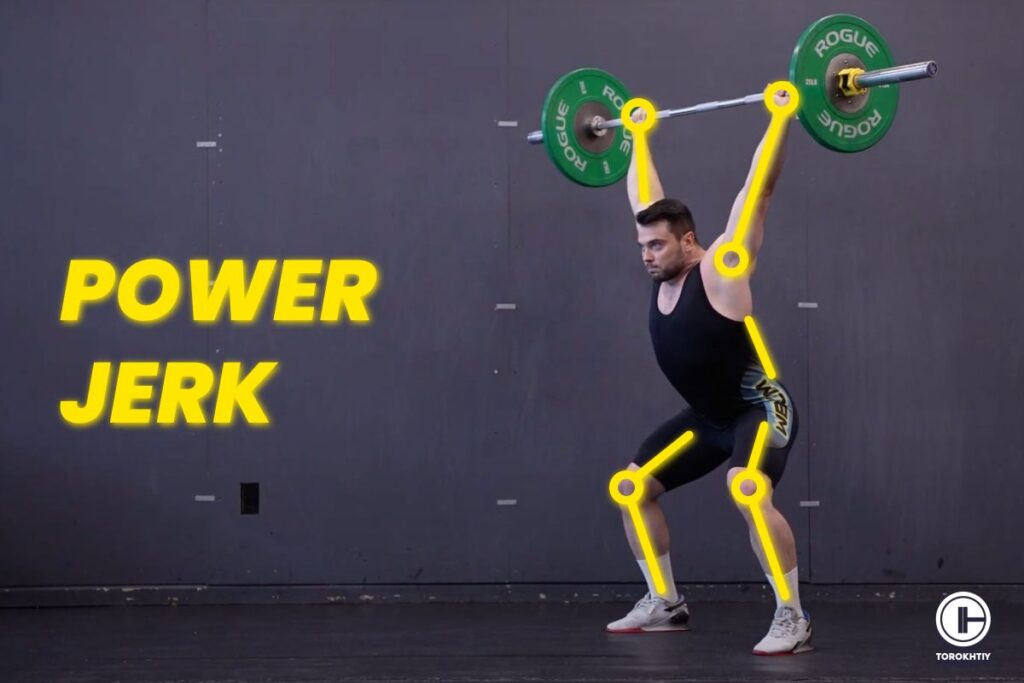
What Is the Power Jerk?
The power jerk is an explosive, powerful weightlifting exercise that helps improve strength and athletic performance. You start with holding a bar at shoulder height, then dip a little before exploding up with your legs and finally, catching the bar overhead. It’s all about generating force from your lower body and stabilizing the weight overhead.
This exercise targets many major muscle groups, including shoulders, arms, core, and legs, so it’s a full body workout. The power jerk builds muscle and strength, and it also improves coordination and balance.
How to Do the Power Jerk?
The power jerk seems pretty cool, right? Let’s see how to do it!
1. Setup
Place the bar at shoulder height on a squat rack. Stand with your feet shoulder-width apart and make sure they’re aligned evenly so you have a stable base for the lift.
Grip the bar slightly wider than shoulder-width, with your palms facing forward and your elbows pointing down and out a little.
2. Starting Position
Lift the bar off the rack and take a step or two back to clear the rack. Keep the bar resting on your shoulders, with your chest up and your core engaged. Your feet should stay shoulder-width apart and your elbows should point forward a bit – more than for a press and less than for a front squat.
This is your starting position and if you do it correctly, you’ll have a stable foundation and a good starting point for the next phase.
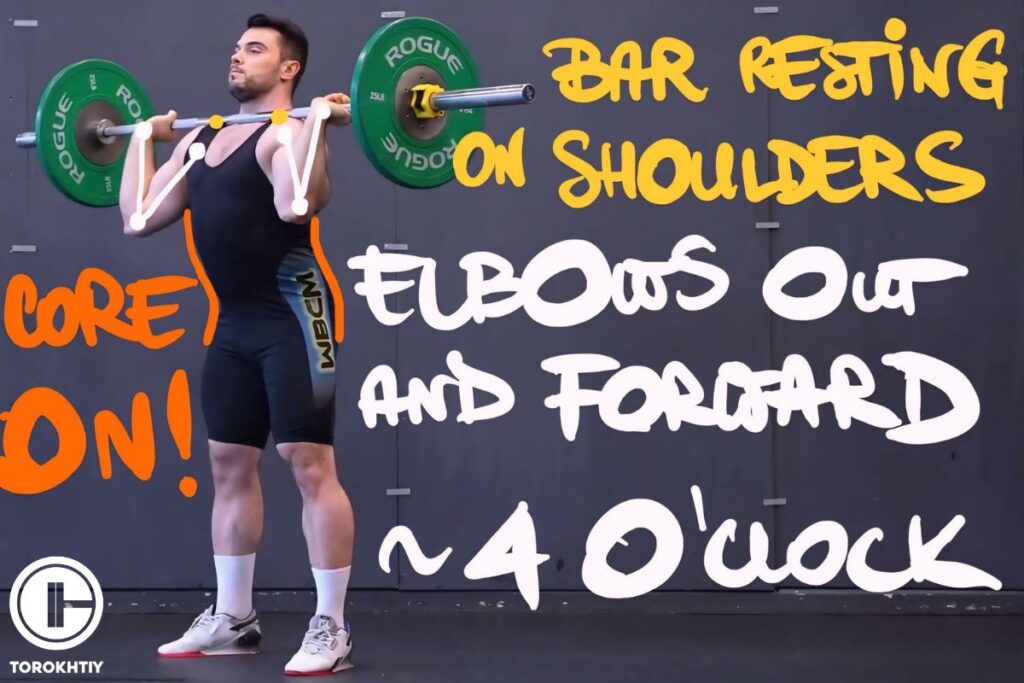
3. Dip
Start to dip in a controlled and smooth way – bend your hips and knees and lower your body a few inches, with your torso staying upright. This should be a controlled movement, loading your legs for the drive.
Don’t lean forward and don’t let your heels come off the ground to maintain balance and power.
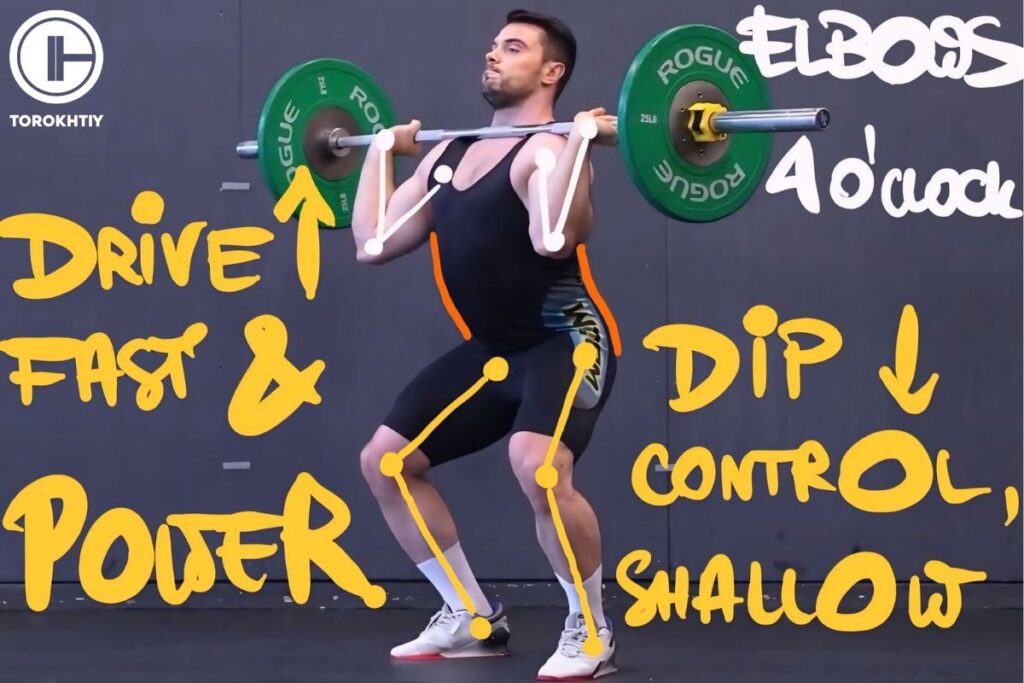
4. Drive
Immediately after the dip, drive up explosively with your legs like you would like to jump (you can actually). Extend your knees and hips powerfully to generate upward momentum and transfer the energy from your lower body through the torso.
As you drive up, push the bar off your shoulders and start extending your arms. This explosive movement is key to lifting the bar overhead, and studies have shown that optimizing this phase, especially by minimizing the transition time between the dip and drive, is important for maximizing power output.
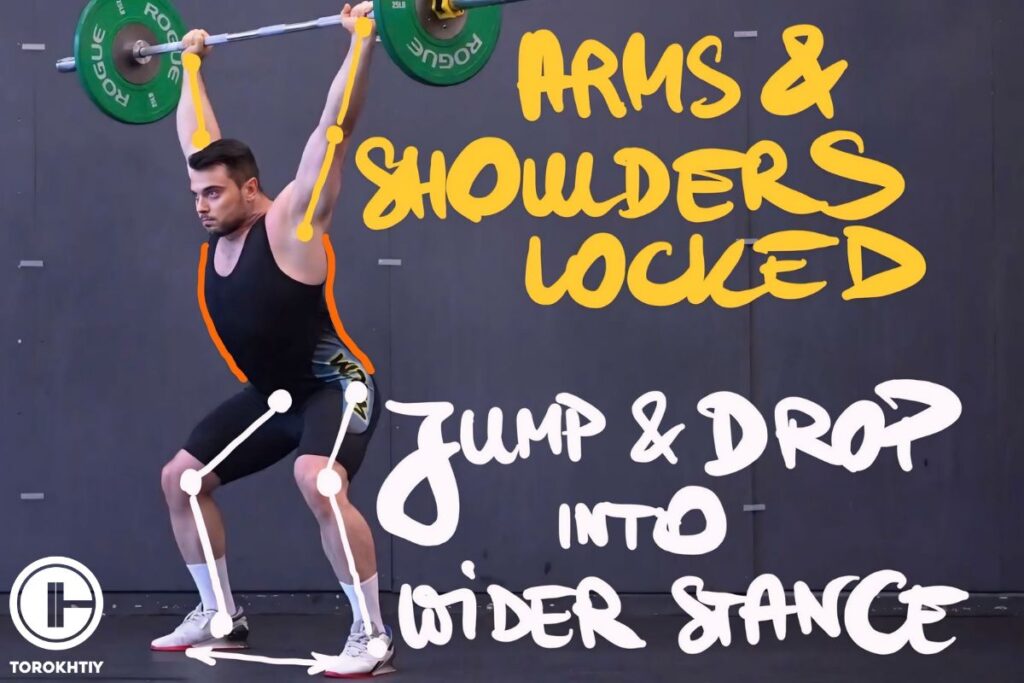
5. Jerk
As the bar rises above your head, quickly bend your knees and hips and drop into a partial squat. You “punch” the bar up which will allow you to drop and push yourself down for a catch. With the power jerk, you catch the bar in a half or deeper squat with your legs wider than they were initially. This will allow you to get under the barbell and catch it with your arms fully extended.
Quite often that extra wider stance gives lifters better hip mobility and allows them to perform power jerk with heavier weights. Once the bar is stabilized overhead, stand up straight to complete the lift.
Make sure your arms are locked out and your body is aligned before lowering the bar back to the starting position.
And that’s it! You did a power jerk, congrats!
Save it for easy access!
Bookmark this page now to access the program and instructional videos anytime, anywhere.
Stop wasting time searching during your gym sessions.
How to Program Power Jerk?
| Level | Reps | Sets | Frequency |
|---|---|---|---|
| Beginner | 3-5 | 3 | 2 times per week |
| Intermediate | 1-3 | 3-5 | 1-2 times a week |
| Advanced | 1-3 | 3-5 | As many times as you want |
Beginner
- Start with 3 sets of 3-5 reps per set
- Do the power jerk 2 times a week
- Start with super light weights or, better yet, an empty bar to master the power jerk technique. Make sure you’re warmed up properly to prepare your muscles and joints. Once you learn the form, you can increase the weight by 5 to 10 pounds
Intermediate
- Do 3-5 sets of 3-5 reps per set
- Do the power jerk 1-2 times a week
- Start increasing the intensity; add the weight in 5 to 10-pound increments and keep it challenging, but manageable. Focus on explosive power during each lift and do accessory exercises like front squats and push presses to build strength and support progress
Advanced
- Do 3-5 sets of 1-3 reps per set
- Do the power jerk as many times as you want and can recover from. Change volume and intensity and work on different qualities.
- Advanced lifters should focus on both adaptation and optimization depending on their schedule. Make sure to leave enough time for rest and recovery
Follow us!

Free!
Get a 2-week Weightlifting Program as a bonus for the subscription to kickstart your training plan!

Free!
3 Common Power Jerk Mistakes
❌ Improper Grip and Hand Placement
If you grip the bar too narrow or too wide, it will mess with your control and stability. Your hands should be a little wider than shoulder-width apart, with elbows slightly out and pointing around 4 o’clock.

❌ Insufficient Dip & Drive
The dip needs to be controlled and the drive must be aggressive, but a lot of people dip too deep or too shallow. A shallow dip won’t generate enough power and a dip that’s too deep may hit you too hard. Work on Power Jerks with pause to find a sweet spot.
❌ Leaning Forward During the Dip
Don’t lean forward during the dip because that will shift your balance and make you lose control. Keep your torso upright and your weight centered over the feet. Bar path should be as vertical as possible.

3 Benefits of Power Jerk
✅ Better Power & Explosiveness
This exercise is all about generating explosive power and it’s especially good for athletes that need quick bursts of energy, like sprinters, football players, and martial artists.
Tips From the Champ
Power jerks are all about coordination and driving the bar overhead with precision. Keep your core tight and be explosive in your dip and drive – this move is a test of leg power and control. Also make sure to keep the arms relaxed till the full body extension in drive. During the catch push aggressively against the bar for solid catch in overhead.
Olympic Weightlifting Champion
✅ Improved Coordination & Balance
The power jerk depends on precise timing and coordination between your upper and lower body. This improves your overall balance and neuromuscular coordination.
✅ Stronger Core
If you want to keep the barbell overhead, your core will have to do some serious work. Over time, it will get stronger, and a strong core improves performance, prevents injuries, and you’re at less risk of back pain.
2 Power Jerk Variations
1. Power Jerk with Bar Behind the Neck
Start with the bar resting on your shoulders behind your neck and do the power jerk like you normally would. This variation focuses on a more vertical bar path and it can improve shoulder mobility and stability. It’s also easier on your wrists and elbows, so if for some reason you have problems with the front rack position – this is a great option for you.
2. Power Jerk with Pause
Do a normal power jerk, but pause for 2-3 seconds in the dip position. This exercise improves balance, stability, and control because it forces you to maintain tension and good form during the lift. It also helps identify and correct technical flaws in the dip.
2 Power Jerk Alternatives
1. Push Press
The push press is kind of like the power jerk, but there’s less leg movement and much more arm work. After the initial dip and drive, you press the bar overhead using your shoulders and arms without dropping into a squat. It’s excellent for building shoulder and tricep strength but it still engages your lower body, too. A lot of coaches use it to improve athletes’ physical development.
2. Power Jerk with Kettlebells
Hold a kettlebell in each hand at shoulder height and do the power jerk. This improves unilateral shoulder stability and coordination because it needs more control and balance, since your arms are moving independently. It’s also good for correcting muscle imbalances. The demand for shoulder rotation is quite different since your hands are not fixed to the object (barbell) and can rotate.
Very challenging so if you’re struggling, try with a single KB first.
Who Should Do the Power Jerk?
1. Athletes
Athletes will benefit from the power jerk because it boosts explosive power, coordination, and strength. It’s especially useful for sports that need quick bursts of energy, like football, basketball, soccer, etc. because of requirements for aggressive and powerful hip and knee extension. Can also teach folks to produce but also absorb the force.
2. Weightlifters
The power jerk is crucial for lifters; it’s a key exercise for improving lifts like the clean and jerk. It helps build strength and technique needed for better performance in competitions. Even if you prefer to split jerk, power jerk still will be an excellent tool in your training routine.
3. Fitness Enthusiasts
Anyone passionate about general fitness can benefit from the power jerk. It’s great for building strength, coordination, and overall athletic ability.
Muscles Worked by the Power Jerk
The power jerk works your entire body.
When you press the bar overhead, your shoulders, triceps, and upper chest do most of the work. The dip and drive phase engages your quads, hamstrings, glutes, and calves and gives your legs a good workout.
Your core stays engaged to keep you stable and your traps and upper back help support the bar overhead.
Conclusion
The power jerk is an excellent exercise – it builds power, coordination, and strength, so it should definitely be part of your routine. Now you know everything that’s important – how to power jerk, what mistakes to look out for, how to include it into your routine, and you even have some variations and alternatives to try out.
Just make sure to always prioritize form because otherwise, it won’t be as effective, and keep those weights manageable; don’t push yourself too far.
What are your thoughts on the power jerk? Have you tried it? If you have, what power jerk benefits have you noticed?
Share your thoughts and experiences in the comments below!
Also Read:
- CLEAN & JERK
- Split Jerk
- Push Jerk
- My Top 3 Exercises for the Split Jerk Stability
- Top 3 Exercises for Jerk Dip & Drive
- Snatch vs Clean & Jerk
References:
- Chris Bishop, Shyam Chavda, Anthony N. Turner, “Exercise Technique: The Push Press,” Strength & Conditioning Journal 40, no. 3 (2017): 1.
- Hyoung-Kil Park, Min-Kyung Jung, Eunkyung Park, Chang-Young Lee, Yong-Seok Jee, Denny Eun, Jun-Youl Cha, and Jaehyun Yoo. “The effect of warm-ups with stretching on the isokinetic moments of collegiate men.” Journal of Exercise Rehabilitation 14, no. 1 (2018): 78–82.
- K. Ai, W. Cao, “Biomechanical Characteristics of Jerk Technique,” in Proceedings of the 13th International Symposium on Biomechanics in Sports, Coaching and Sports Activities section (1995).
- Kuan Dong, Tenghao Yu, Buongo Chun “Effects of Core Training on Sport-Specific Performance of Athletes: A Meta-Analysis of Randomized Controlled Trials,” Behavioral Sciences 13, no. 2 (2023): 148.
- Zachary Smrcina, Sarah Woelfel, Christopher Burcal “A Systematic Review of the Effectiveness of Core Stability Exercises in Patients with Non-Specific Low Back Pain,” International Journal of Sports Physical Therapy 17, no. 5 (2022): 766-774. eCollection 2022.
- Photos by Torokhtiy Media Team.
Why Trust Us?
With over 20 years in Olympic weightlifting, strength training, nutrition coaching, and general fitness our team does its best to provide the audience with ultimate support and meet the needs and requirements of advanced athletes and professional lifters, as well as people who strive to open new opportunities and develop their physical capabilities with us.
By trusting the recommendations of our certified experts in coaching, nutrition, and sports training programming, as well as scientific consultants, and physiotherapists, we provide you with thorough, well-considered, and scientifically proven content. All the information given in the articles concerning workout programming, separate exercises, and athletic performance, in general, is based on verified data.
The product testing process is described in more detail here.
Author: Oleksiy Torokhtiy
Olympic Weightlifting Champion
Best Results: Snatch – 200 kg,
C&J – 240 kg
Oleksiy Torokhtiy is a professional athlete boasting 20 years of experience in Olympic weightlifting. With multiple European and World titles under his belt, he has showcased his prowess in two Olympic Games (Beijing 2008 and London 2012). Upon concluding his illustrious career, Oleksiy dedicated himself to coaching. By 2022, he had conducted over 200 weightlifting seminars worldwide. He is the visionary behind an international sportswear and accessories brand known for its motto, “Warm Body Cold Mind.” Additionally, he is an esteemed author and the creator of a series of training programs and eBooks.




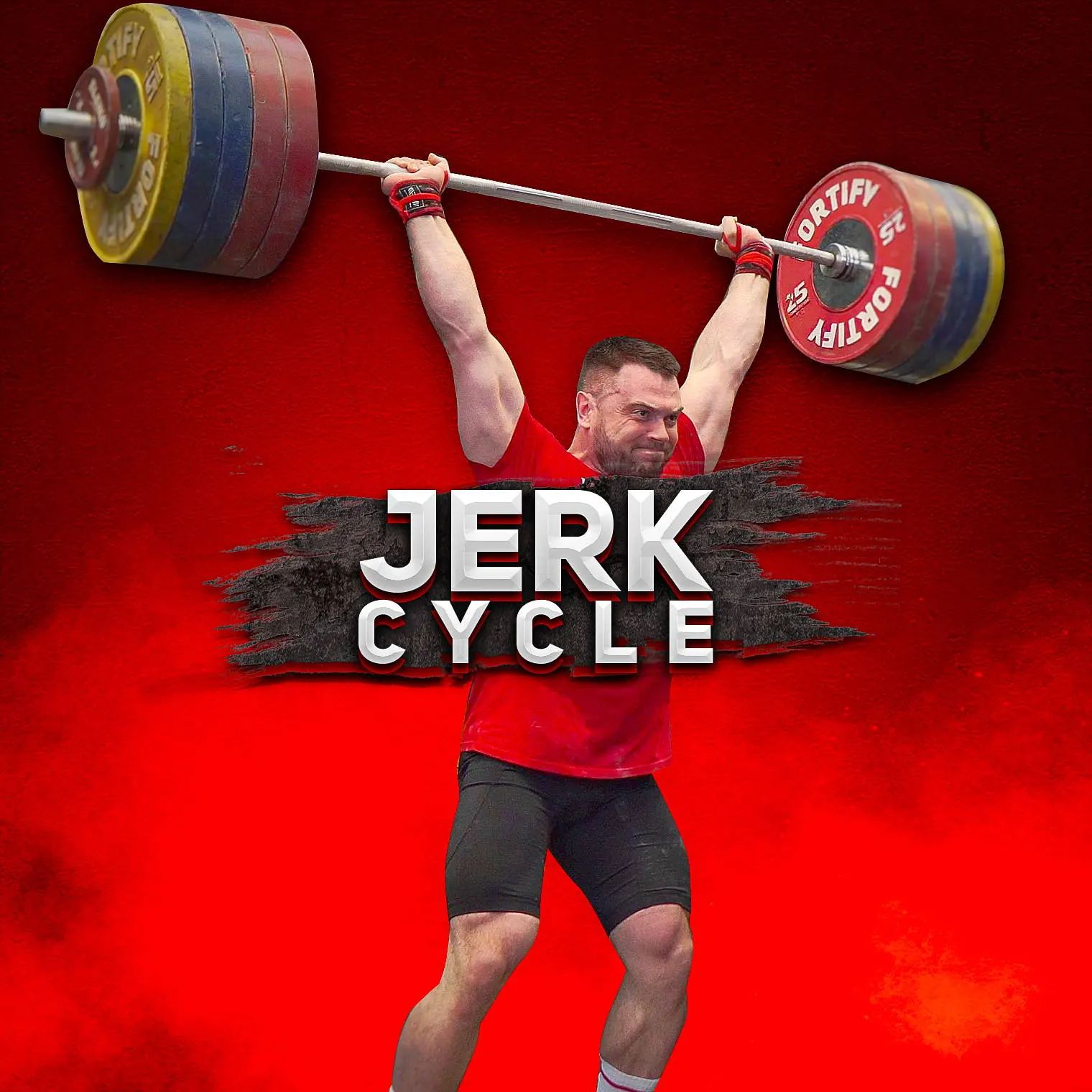
Still have questions after reading our article? Unlock your full potential by engaging with our experts and community! Don’t hesitate — leave a comment below and Oleksiy Torokhtiy will provide a personalized answer and insights to help you reach your goals.